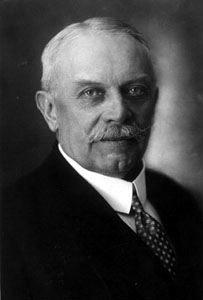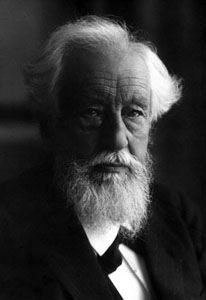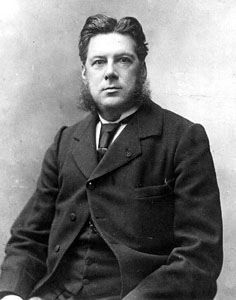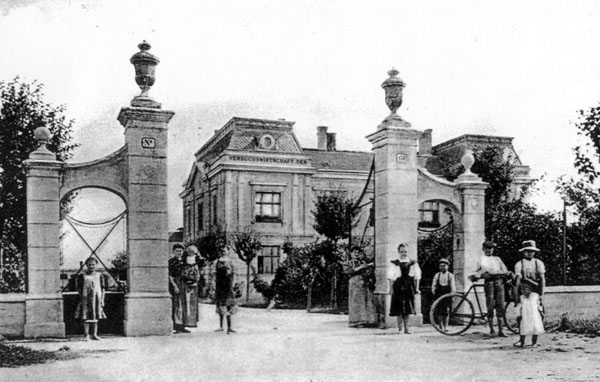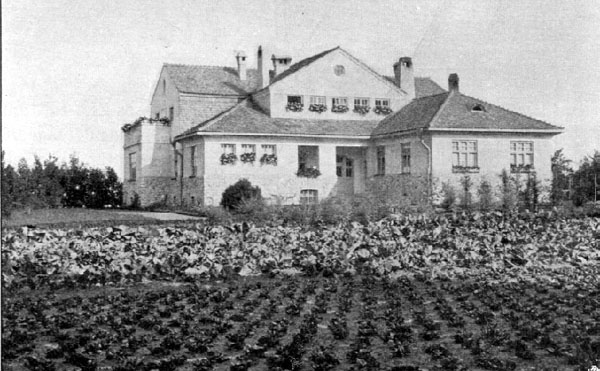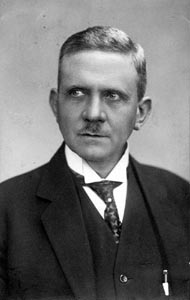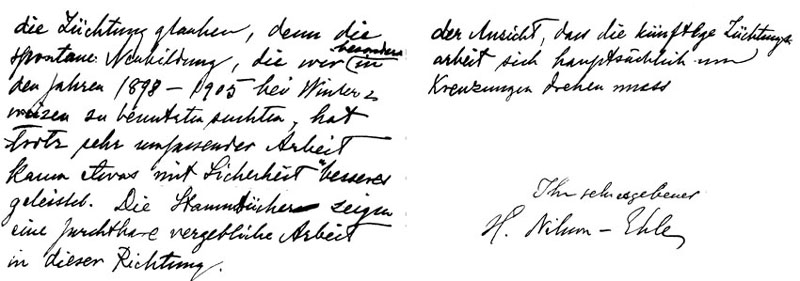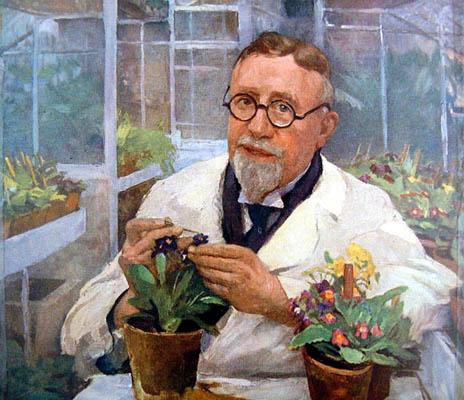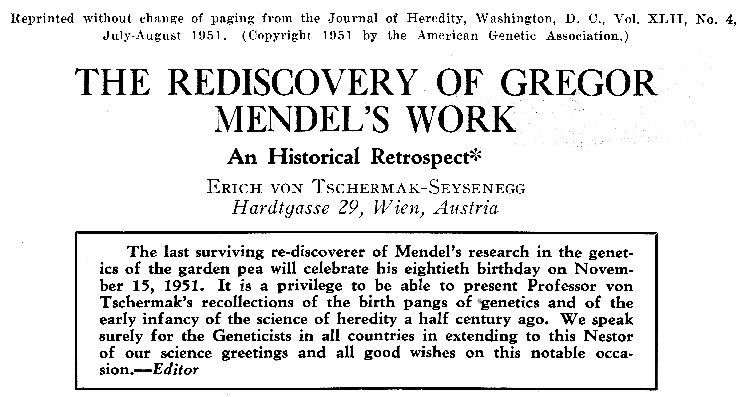1956, Erich von Tschermak-Seysenegg | Austria †
It was the fate of Gregor Mendel's name to be known by only a few during his life, to be almost forgotten for decades, but to be mentioned today by the world-wide community with great admiration and deepest respect.
The 100th anniversary of the rediscovery of the experiments of the Augustinian Abbot Gregor Mendel (1822 – 1884) by C. E. Correns, E. v. Tschermak and H. de Vries marks one of the milestones of science in this century with respect to the epochal advancements of genetics and their global applicability in daily life of mankind.
Prof. Dr.Dr.h.c.mult. Erich von Tschermak-Seysenegg (Fig. 1) was the second Austrian scientist after Mendel who again detected the laws of inheritance by looking for the occurrence of xenia in pea crossings and the first plant breeder who purposely applied the combination of genes as a scientific method to improve the agronomic characters and therefore the efficiency of cultivated plants in practical plant breeding.
Taking Tschermak's impressive scientific work with about 100 original papers, the observer notices not only the manifold range of topics but also their originality of his experiments, observations and theories.
Above all, his merits stand for the rediscovery of the „Mendelian Laws of Inheritance“ in the year 1900 – simultaneously with Carl Correns and Hugo de Vries – which Tschermak detected in the same plant species Mendel worked about half a century ago. Despite the contradictory opinions and publications about the independent discovery by all 3 scientists, by thoroughly studies of Tschermak's estate in Vienna we found a new approach to elucidate the independence of his re-discovery.
E. v. Tschermak was guided in his tortuous way to this important discovery by his favourite interest for xenia, on which he started his scientific carrier in 1897 (Tschermak 1898).
Xenia are genetic phenomena where under special genetic preconditions characters on the mother plant offer hybridisation effects caused by the pollen after fertilisation. Different reasons can be named for these phenomena. In legumes, such as peas e.g. the occurrence of yellow and green colours of the cotyledons in different types could have led to the twofold detection of the knowledge about inheritance of parental characters. In a number of pisum crosses, the F1-hybrids resemble the difference of cotyledon colours in the seeds and the alternative seed shapes of the parental partners already in the pods of the F1-plant and are easily to distinguish from each other. These xenia-effects can then be used to demonstrate the segregation of the parental characters since the seed grains can be classified in alternative groups in the same year of production! Most sporogenous responses are not apparent after the cross until the hybrid seeds are planted and the characters become visible in the progeny plants only. However, in peas the difference in the colour of the cotyledons (yellow vs. green) or the shape of the kernels (round vs. wrinkled) of the crossing partners shows its F2-segregation of the progenies already on their ripe F1-plants! It is obvious that the observer will plant this segregating seed lot individually to follow their behaviour in the F2-generation!
Family background and studies in Vienna and Halle
To follow the way about the history of the rediscovery of the laws of inheritance in Vienna, one has to learn some facts about the unusual curriculum about this Viennese citizen Erich v. Tschermak-Seysenegg.
He was born in Vienna on the 15th of November 1871 as the third child of a well-known Viennese family of scientists. His father Gustav Tschermak (1836 – 1927) was professor of mineralogy at the University of Vienna and the founder of the isomorphic behaviour of silicates. His grandfather on his mother’s side was Eduard Fenzl (1808 – 1879), professor of botany at the already mentioned university and director of the botanical garden in Vienna.
The roots of the family history of his father can be traced back to old Moravian families such as Czermak, Daniel, Karl and Nitschmann. The later named ancestors were related (!) to the Mendel family in Heinzendorf, the home village of the famous offspring of this family – Gregor Mendel.
His mother’s side descended from families of Upper Austria in the border town of Passau/Germany comprising therefore the whole north-western part of the former Austrian-Hungarian Monarchy. His roots, his education and his later life-style reflected very much the fundamental change of the end of the 19th century in nearly all fields of human activities. His basic education he received from the padres of the clerical gymnasium at Kremsmünster. After a time of hunger and hardship, but full of schoolboy-jokes, he began to study agricultural science in 1891 at the former „Hochschule für Bodenkultur” (now the University of Agricultural Sciences Vienna) and simultaneously biology at the University of Vienna. His great interest for botany and chemistry also forced him to try this rather unusual step at this time for a student of agriculture. After one year only, Tschermak interrupted his studies and worked for one year (1892 – 1893) as an agricultural volunteer in a manorial estate in Freiberg/Saxonia. Stimulated by friends and having contact with agronomists trained at the University of Halle, he dislocated his study place from Vienna to Halle, where he continued to study agriculture from autumn 1893 until 1895. First he graduated as „Diplomierter Landwirt” (equivalent to a B.Sc. in agriculture). One of his Hallenser professors noticed his preference for botanical topics and offered him a Ph.D. study in applied botany. He experimented with a thesis about „staining of the conductive vessels in dicotyledonous herbaceous plants and shrubs”. Rather disappointed about the results of his work he received the doctor’s grade after a „mild” examination with the grade „probibiter” in December 1896.
During his study time in Halle/Saale he built up a friendship with Kurt v. Rümker, which lasted over his whole life time and opened him many ways towards a scientific approach in plant breeding (Fig. 2).
Volunteering times in Germany, Belgium, The Netherlands and France - Tschermak's way ahead to practical breeding activities
To support his further professional career, his father sponsored him further training leaves in breeding stations for vegetables and ornamentals in Stendal (1896/97) and in Quedlinburg (1897/98), both in Saxonia.
Here he was confronted the first time with practical breeding activities such as mass-selection in legumes, cabbages, lettuce and ornamentals. Later he acquired experience in crossing-techniques – a skill, which significantly determined his whole scientific life as a plant breeder. Back to Vienna in the early 1898 he found the desired position as an university assistant still occupied by someone else. So he travelled again, this time to Gent and Paris, where he found the opportunities to see huge horticultural estates and legume breeding stations. Lucky enough he received the permission to start crossing experiments with wallflowers (Erysimum chéiri) and garden peas (Pisum vulgare L.) in a cold house of the botanical garden in Gent. There he found in the library Darwin’s book „The cross and self pollination in the kingdom of plants” which inspired him to search about seldom pollination effects leading to xenia or neighbouring pollination phenomena (geitogamy) or crossing effects between individuals of the same species (heteromorphic xenogamy). These peculiarities, observable on pods of Erysimum and Pisum after crossing, do have several reasons but are mainly due to the influence of the pollinator causing different colours and morphological variations. Tschermak concentrated these studies – limited by time pressure and taking the chance of supply with garden peas of different characters – to peas, of which the green house was full – the right moment and the right man for rediscovering the laws of inheritance, which Mendel found in this „easy to cross object”.
After this experimental time in Gent the seeds of his experiments were sent to Vienna (as samples of individual plants) by „non-registered” mail for further multiplication, while Tschermak travelled to the Netherlands and met the Dutch botanist Hugo de Vries (Fig. 3) in Amsterdam. De Vries showed him his mutants of Oenothera lamarckiana, but did not tell him
about his recent experiments with peas. Tschermak: „I was too humble to tell him about my work in Gent – otherwise De Vries would have mentioned that I am on the track of Gregor Mendel!” De Vries was delighted about the interest, the young Austrian scientist showed in his work, so he put him on his mailing list for the exchange of scientific papers. (Later, 1903, De Vries donated the two volumes of his book „Theory of Mutations” to Tschermak). So, Tschermak became aware of the segregation experiments De Vries performed in those days.
After another study tour to France (1898) where he met H. L. de Vilmorin (Fig. 4) in Paris and visited his huge facilities for vegetable and champignon breeding and also Prof. E. Schribaux, who led the small Institute of Plant Breeding in the agricultural college in Grignon near Paris, he returned back to Vienna to look for another start in the field of his interest. In an agricultural estate near Vienna, he continued the work with the progenies of his pea-crosses of the volunteering time in Gent. Hereby Tschermak observed the phenomenon of xenia in the seed pods of the same F1-plants, whereby seed colours and seed shapes resemble the difference in parental characters at this early stage after hybridisation. These observations and the results of some back-crossing procedures in which parental characters appeared in a 1:1 segregation scheme when the hybrids were crossed again with their parental types, formed the basis of his D. Sc. thesis („Habilitationsschrift”) which he delivered to the university authorities in January 1900. In this publication (Tschermak 1900) he demonstrated and discussed some of the results of his experimental studies. Such results with peas have already been achieved half a century before by Mendel (1866) but neglected by the scientific
community at that time. In March of the same year, De Vries (1900 a, b) published similar papers about pea crossing and – coincidently (?) Correns (1900) launched in the April volume of the same periodical (Berichte der deutschen botanischen Gesellschaft) a third paper about the same topic, but with special reference to Gregor Mendel’s experiments and figures from 1866!
Several opinions have been launched about the so called „independent rediscovery of the Mendelian laws by Correns, Tschermak and De Vries in 1900”. There are still some doubts about these „random publication events” within a few months in the year 1900. Some of the irregularities in the paper of Tschermak (1900) were criticised in recent years (Monaghan and Corcos 1986, 1987).
Tschermak's first activities and significant contributions to apply Mendel’s rules into practical breeding
Soon after the period of rediscovery, Tschermak became fully aware that these fundamental principles of inheritance „must be” applied to achieve stable and uniform combinations of different characters of parental genotypes by crossings, individual selection and separate testing of the progenies in all agricultural crops. So he advocated the system of „combination breeding” instead of the only individual ear selection of phenotypically equal plant types within populations, which was very common in creating „improved” varieties at that time. Due to his excellent crossing techniques and improved selection management he started first with cereals. With various crossings of rye and wheat varieties of different origins he tried to solve one of the most important problems cereal breeders were confronted with in the dry areas of Lower Austria, Moravia and Western Hungary, namely to combine earliness with high yielding performance (Tschermak 1901, 1906). The later performance of many of his varieties in barley and wheat showed perfectly the possibility to combine successfully even these negatively correlated characters!
To prevent his leaving for a new professorship from Vienna to Brno (Technical University) and Wroclaw (University), the Viennese authorities of the „Hochschule für Bodenkultur” promoted him to the position of an „Assistant Professor” (1903) and founded in 1906 a separate chair of plant breeding („Lehrkanzel für Pflanzenzüchtung”) for Tschermak. It was the first established chair for plant breeding in Europe, poorly adapted but a permanent position for his great planes and further activities.
At the experimental farm of the „Hochschule für Bodenkultur” in Gross-Enzersdorf, about 25 km east of Vienna, he founded 1903 the first plant breeding station (Fig. 5), partly with the
help of an US donation (sic!). After a study tour to the United States, where Tschermak and Rümker became acquainted with the steep rise of genetic science within agricultural research in this part of the world and after a publication of comparisons between the United States and Europe (Tschermak and v. Rümker 1910), the Prince of Liechtenstein showed his interest in this prospective field of agricultural developments and founded 1913 a new institute for plant breeding, the „Mendel-Institute” in Lednice (former Eisgrub) (Fig. 6). These new prospects stimulated Tschermak to move his breeding material for peas, beans and flowers (mainly primroses), but also some of his cereal lines to Lednice, where for the first time the staff and the equipment was adequate to promote his breeding activities in a wide range of agricultural crops including vegetables. Here he started the selection of early pea types (Victoria) from crosses „pois acacia” X „pois a cinq cosses” and nearly all his work with ornamentals. His earlier co-operation (since 1904) with the nestor of the Moravian plant breeders E. v. Proskowetz extended then his activities particularly in the field of spring barley breeding.
E. v. Proskowetz tried since 1875 to improve the old barley land-races of his district Hanna by ear selection at his agricultural estate Kvasice u. Tlumacova. Tschermak convinced him to change to individual selection and progeny testing and could find particularly early and high yielding lines of malting barley. The so called „Kwassitzer Original Hanna Pedigree” become the mother of a wide range of malting barleys in Europe because of its high grain quality, earliness, yield stability and high adaptability. In Germany many years after the release of this variety, 14 sister varieties (Mittlauer Hanna, Eglfinger Hado, Mahndorfer Hanna, Heines Hanna, Oppiner Hanna, Weihenstephaner Hilte, Braunes Hanna, Dippes Hanna, Selchower Landgerste, Heines Haisa, Criewener 403, Rimpaus Hanna and Mettes Hanna) demonstrated this early selection triumph which was similarly successful in Sweden (Svalöf‘s Hannchenkorn, Svalöf‘s Hannchengerste 2) (Wunderlich 1951).
The progress of these activities in Moravia and the urgent need for better and more stable varieties in cereals and other crops motivated Tschermak to establish additional experimental sites and plant breeding stations within great agricultural estates most in the important agricultural areas of the Austrian-Hungarian Monarchy which were Bohemia, Western Hungary and last not least in Lower Austria. So, within a few years from 1903 onwards the „talented organiser” Tschermak established after the foundation of Gross-Enzersdorf (1903), Lednice (1913) and Kvasice (1904) further 18 (!) additional experimental field and plant breeding stations first in Moravia, then in Bohemia, Western Hungary and Lower Austria. Their present and former names and some of the significant breeding successes are listed as follows (Feichtinger 1932, Tschermak 1958) (Tab. 1):
Table 1: Plant breeding stations founded by E. v. Tschermak in former Austrian-Hungarian Monarchy and in Austria
| In Moravia 1903 - 1912 | |
| Hodonin (Göding): | for rye, wheat, barley, legumes, soybean |
| Krumlov (Krumau/Frainspitz): | all his cereal and legume material (spring wheat variety „Lednitzer Glattweizen”) |
| Zborovice (Zoborowitz): | all his cereals (variety „Zborowitzer Kolbenweizen”) and legume material, mainly peas, faba beans and poppy (variety „Zborowitz blue poppy“) |
| Nezamyslice (Nezamieslitz, estate Dolloplass): | only for wheat testing |
| Stráznice (Steinitz): | cereal and legume breeding activities (winter wheat „Moravia”) |
| Breclav (Lundenburg): | centre for wheat breeding (winter wheat variety „Hochschulweizen”) |
| Uhersky Ostroh (Ungarisch Ostra): | station for wheat, barley (varieties „Jubiläumsweizen” and „alpha-Gerste”), small seed faba beans |
| In Bohemia 1904 – 1916 (?) | |
| Lysa nad Labem (Litol nahe Lissa): | centre for barley breeding, wheat testing |
| Dettenice (Liban-Detenitz via Kopidlno): | barley breeding (variety „Hanna” X „frühe Gold-thorpe”) |
| Panenske Brezany u Prahy (Jungfern Brezan): | wheat and barley testing, multiplication |
| Dobrovice (Dobrowitz): | sugar beet breeding, first triticale breeding activities |
| Pruhonice (Pruhonitz): | primroses and ornamental breeding |
| In Hungary 1917 | |
| Bükk: | cereal testing and multiplication |
| In Lower Austria 1906 – 1928 | |
| Probstdorf 1924: | all cereal breeding activities, pumpkins and legumes (varieties winter wheat „Weißer begrannter Marchfelder”; spring wheat „Znaimer X Tucson”; winter rye „Tschermak‘s Marchfelder”; winter barley „Tschermak‘s zweizeilige Wintergerste”; oat „Tschermak‘s Frühhafer”) |
| Dürnkrut 1906: | cereal breeding |
| Markgraf Neusiedl 1921: | legumes and ornamentals |
| Süssenbrunn 1928: | rye, wheat and barley multiplication |
| Brunn/Gebirge 1922: | bean-, lentils- and vetch-breeding |
Tschermak's efforts for the distribution of Mendel's ideas in combining valuable characters in field crop varieties
With all respect and admiration for the 3 re-discoverers of Mendel’s outstanding work, the individual attitudes of Correns, De Vries and Tschermak towards the importance of these laws of inheritance could not be more different than among these personalities.
The botanist De Vries was always involved and fascinated about questions of the theory of the origin of species and the role mutation played in the evolution of plants. Besides that he carried out crossing experiments with Oenothera lamarckiana X Oe. brevistylis in 1895, where he observed the uniformity of his crossing hybrids and the „dominance” of some prevailing characters. The detection of a citation of Mendel’s work in the book of Focke (1881) and the study of Mendel’s publication guided De Vries to work with peas. In his first report about the segregation of his pea hybrids (De Vries 1900 a) he did not mention Mendel’s name, but used the expressions „dominant” and „recessive“. In the second, more precise paper (De Vries 1900 b) he confirmed Mendel’s result but concentrated again on his „Mutation theory”, which he published in 2 volumes (De Vries 1901 and 1903). He was convinced that breeding efforts should concentrate in looking for spontaneous variations within population caused by „retrogressive and degressive” mutations. He presumed the effects of „pangenes”, which modify the expansion of characters within populations. When he visited Svalöf in 1901, the wealth of different forms was so overwhelming, that De Vries convinced the breeders there that selection of „elementary units” within populations was the only method needed in plant breeding. (This was of course not Mendel’s approach, so in De Vries textbook „Pflanzenzüchtung” [1907] again he did not mention Mendel’s work any more). So, the „Mutation theory” of De Vries fitted into their experiences and their promising results and started to become the theoretical base already established at Svalöf. Tschermak also visited Svalöf in 1901 and presented to the new wheat breeder H. Nilsson-Ehle (Fig. 7) the idea that only Mendelism could provide „a new, rational basis” for the breeding of new constant forms of plants by hybridisation. So, combining of characters could proceed substantially more surely and simply than before (Tschermak 1901).
The discussion about these 2 different opinions between the 2 rediscoverers suggests how Svalöf became a „hot house” for testing new ideas of heredity and evolution. However, the practical results achieved by the breeders with spontaneous mutations in all sorts of land races was disappointing. In 1906 Nilsson-Ehle finally promoted hybridisation as the most important part of the coming breeding programmes of Svalöf. The improvement of winter wheat had run into trouble because all the new promising „elementary units, off types or races” that had been found by selection in populations suffered from one or more serious weaknesses. If hybridisation could be used to combine good properties and eliminate weaknesses, new progress would be possible (Nilsson-Ehle 1908). In this connection Nilsson-Ehle used to refer always to the visit of Tschermak as a main source of inspiration for his steps towards crossing methods. It was reported that most of Nilsson-Ehle’s scientific correspondence is lost. It is said to have been burnt by himself after his wife‘s death. Fortunately enough we found recently in the estate of Tschermak in the Academy of Science Vienna a letter of Nilsson-Ehle to Tschermak from August 14th, 1909 from Cambridge (Fig. 8 a) in which he critiqued strongly the former practices of selecting „off types” within population to create better varieties: „... than the spontaneous new form, which we specially tried to select and utilise in winter wheat in the years from 1989 – 1905 did not prove – even with extremely strong efforts – better results. The pedigree books show a terrible useless work in this direction (translated into English). ... the opinion, that the future breeding work must concentrate itself mainly in crossing work. Yours very truly N. Nilsson-Ehle.” (Fig. 8 b)
In the following years Tschermak nearly revolutionised „the state of art” in plant breeding. With his enthusiasm, his broad horizon and his toughness to overcome all sorts of problems he established not only a dense network of breeding stations, but kept the survey over all activities and guided his countless former students and now co-workers over a period of nearly 60 years! Not to forget his enormous manual skills in crossing techniques which helped him to tackle not only difficult hybridisations in cereals (e.g. oat), but also other species used in agriculture and particularly in ornamentals. Additionally to this talent his knowledge about flowering biology was constantly the base of his early successes in creating new varieties and new forms of ornamentals.
The very impressive list of his varieties (Tab. 2) in winter rye (2 varieties), winter wheat (13), spring wheat (1), winter barley (1), spring barley (6), spring oat (3), garden peas (2), garden beans (2), faba bean (1), oil pumpkin (1) as well as numerous vegetable varieties such as in string beans, runner beans, tomatoes, cabbage, carrots, onions, radish and his numerous ornamentals (Tschermak 1951) reflects his impressive working capacity. Once, he called himself a „pathological worker”.
Last not least his favourite passion for breeding ornamentals should be mentioned again (Fig. 9). From his volunteering time onwards he worked with Begonia and Petunia, later with Matthiola, a species which motivated him to solve open questions about xenia. Crosses between Matthiolaspecies guided Tschermak also to form a theory about kryptomeric segregations. In such cases, hybrids between white flowering parental forms produce coloured types in their F2-offspring only
if one of the parental partners carries a dominant or a recessive gene for the white corolla colour. Other long lasting activities with Primula (1903 – 1932) confronted him with more, complex cases of inheritance such as the character „calycanthemic” (Tschermak 1932). By crossing of wild species ofPrimula acaulis, Pr. elatior and Pr. officinalis with cultivated types with calycanthemic or „filled” primroses, Tschermak could combine an abundant blossom-type with a corolla-like shape of the calyx to achieve new, lovely looking blue types of Primula. Hundreds of new phenotypes of ornamentals were the fruits of his passion – particularly in his older days with species like Matthiola, Mimula, Azalea andCodiaea.
Additionally to this respectable performance, he published more than 100 scientific papers and also numberless articles in agricultural newspapers and garden journals to keep the agronomists and the gardeners in the mood to buy seeds or root stockings of new varieties and to use it in a wide range of planting conditions.
But above all, he really was the most successful practical breeder of his time.
Table 2: Cultivated varieties (early and finally from 1925 onwards varieties registered in Austria) of various agricultural crops bred by E. v. Tschermak (incomplete list according to Feichtinger 1932; v. Tschermak 1951, 1958; Wunderlich 1951; Hänsel 1962)
| Winter rye 2 varieties |
- Tschermak’s Marchfelder Roggen (1926) - Prof. Tschermak Roggen (1927) |
| Winter wheat 13 varieties |
- Weißer begrannter Marchfelder (1909, land race reselection from Marchfeld area, later registered in 1927) - Brauner begrannter Marchfelder - Hochschulweizen (1928, from the Hungarian land race Dioszeger wheat) - Zborowitzer Kolbenweizen (reselection of Rimpau’s Bastard) - Russischer Rotweizen (Red Zborowitz wheat X White Russian wheat) - Moraviaweizen (Edelepp X Marchfelder) - Non plus ultra (Svalöf's Grenadier X Banatian wheat) - Non plus ultra I, II and III (Selections of the above named cross) - Glasweizen - Schilfweizen (French Bon fermier X Blé gros bleu) - Excelsiorweizen (Banater X Extra Squarehead Master) |
| Spring wheat 1 variety |
- Znaimer X Tucson (1925) |
| Winter barley 1 2-row variety |
- Kirsche X 2-zeilige Hanna X 4-zeilige Hanna’s Riesen (1927) |
| Spring barley 6 varieties |
- Hanna or Kwassitzer Original Hanna Pedigree-Gerste (reselection of a land race in the Hanna district, released 1908 (?) - Hanna Kargyn (Hanna X turkish land race from Kargyn, world champion in the London Exhibition 1927) - Hanna Kaisarie (Hanna X turkish land race from the district Kaisarie) - Hanna X Chevalier - Hanna X Schwarzenberggerste - Hanna X Hannchen |
| Spring oat 3 varieties |
- Tschermak’s Frühhafer (1931, Svalöf’s Siegeshafer X Hungarian 60-day oat selection) - Tschermak’s Gelbhafer (Lochows Gelbhafer X Svalöf’s Goldregen) - Tschermak’s Weißhafer (Russ. Ligowo X Savlöf’s Goldregen) |
| Legumes 2 pea varieties 2 bean varieties 1 faba bean variety |
- Tschermak’s veredelte Victoria Erbse (pois acacia X pois a cinq cosses) - Saxa X Buxbaum X Saxa - Tschermak’s fadenlose frühe Buschbohne (Wiener Busch X weißgründige Heinrich’s Riesen) - Tschermak’s Feuerbohne (Ph. vulgaris X Ph. multiflorus) - Tschermak’s weißblühende Ackerbohne |
| Pumpkin | - Tschermak’s schalenloser Ölkürbis |
| Flowers etc. | - Many crosses in the species Matthiola, Acaulea, Verbascum, Papaver, Mimula andPrimula |
Tschermak's second approach for the enlargement of variability in cereals and other plant species
To accomplish Tschermak's doubtless merits of a successful introduction of the Mendelism into practical plant breeding, his various experiments and investigations about hybridisation between genera and species certainly must be mentioned. He recognised even at his early time the enormous „treasure” in the wild and related species of cultivated cereals for future breeding possibilities.
The experimental phylogenetic research was not very much developed at his time and the existence of the chromosomal arrangement of amphidiploid species unknown. In his different fertile genera-bastards Tschermak suspected that their existence was derived from non-reduced F1-gamets, like his hybrids between wheat X rye or Aegilops ovata (2n = 28) X Triticum dicoccoides (2n = 28). This last named bastard, which he called „Aegilotricum” (2n = 56) was the first additive genera-bastard artificially produced and cytologically approved (Tschermak and Bleier 1926). This was an opening for the experimental research of the relationship between genera, but also for the production of synthetic types of cultivated plants by polyploidisation of sterile F1-bastards.
The list of genera and species hybridisations performed by Tschermak (1958) offers not the wide range of his activities in this field, but also the excellent hybridisation techniques he developed and mastered: Triticum X Secale, Triticum X Agropyrum, Aegilops X Triticum, Haynaldia X Triticum,Agropyrum X Secale, Radish (Raphanus sativus f. radicula) X Wild radish (Raphanus raphanistrum),Secale montanum X Sec. cereale, (perennial rye), Hordeum trifurcatum X H. compositium, Avena sativaX Av. fatua, Av. s. X Av. brevis, Triticum vulgare X Tr. spelta, Tr. v. X Tr. durum, Tr. v. X Tr. turgidum, Tr. v.X Tr. compositum, Tr. v. X Tr. dicoccum, Tr. v. X Tr. polonicum, Tr. turgidum X Tr. villosum. Further between other species such as Phaseolus vulgaris X Ph. multiflorus, Matthiola incana X M. tricuspicata,Verbascum olympicum X V. phoeniceum, Beta trigynax X B. lomatogona (specification after Tschermak 1958, Hänsel 1962).
Tschermak's personality and life as Professor emeritus
E. v. Tschermak-Seysenegg was a lively Viennese citizen and gentleman with elegant manners and a distinguished academic performance. He was very fond of good food and wine and performed, particularly in his elderly days a more baroquean life-style!
His merits about the importance of Mendel’s experiments were recognised world-wide. He received six times the distinguished title of „Dr.h.c.“ (Doctor honoris causa) from the universities in Berlin 1924, Gießen 1931, Brno 1936, Vienna 1948 – Agricultural Sciences, Vienna 1950 – natural science, Gent 1957. He was member of the academies of sciences in Vienna, Budapest, St. Petersburg, Paris; further he held the membership of the academies of agricultural sciences in Stockholm, Paris, Praha and Berlin as well as the honorary memberships of many distinguished scientific institutions in Europe and overseas.
Tschermak emerited in the year 1941 and spent his last 21 years also in the 19th district of Vienna. On the occasion of his 80th birthday the „Journal of Heredity”, Washington, D.C., dedicated a translation of his personal review on the rediscovery of the Mendelian laws in one of their issues to him (Tschermak 1951, Fig. 10).
He died – eleven months after the impressive celebration ceremony on the occasion of his 90th birthday - in Vienna on the 11th of October 1962. He received a burial place of honour in the cemetery near his home university in the Viennese 19th district (Döbling).
Conclusions
Tschermak, the „founder of the Austrian Plant Breeding” combined happily his experimental merits with the vision into applying Mendel’s ideas in the practical breeding work. Based on this principles, he succeeded not only to convince agricultural institutions to follow this track, but also to establish the strongest network in plant breeding in this particular area of Europe. The countless numbers of new varieties in nearly all agricultural crops and ornamentals were milestones and missions for the unbelievable development plant breeding has made within this century! Today, the fundamental ideas of Tschermak, to purposely combine genes from different genotypes of agricultural crops and to isolate individual plants from their crossing populations and follow the behaviour of their segregants have become routine procedures! His vision and his trust in the theory of inheritance – often attacked at his days – must be seen as an epochal event in this remarkable century.
---
By P. Ruckenbauer
Institute of Agronomy and Plant Breeding, University of Agricultural Sciences
(Universität für Bodenkultur Wien), Gregor Mendel-Strasse 33, A-1180 Vienna/Austria
(This article was originally published in Vorträge für Pflanzenzüchtung 48:31-46 (2000).)
Literature
Correns, C., 1900: Gregor Mendels Regel über das Verhalten der Nachkommenschaft der Bastarde. Berichte der Deutschen Botanischen Gesellschaft 18, 158-168.
Feichtinger, E. K., 1932: Die Entwicklung und die praktische Tätigkeit der Lehrkanzel für Pflanzenzüchtung an der Hochschule für Bodenkultur in Wien und der Pflanzenzuchtstation in Groß-Enzersdorf. Zeitschrift für Pflanzenzüchtung 17, 1-7.
Focke, O.W., 1881: Die Pflanzenmischlinge, Berlin.
Hänsel, H., 1962: Die Bedeutung Tschermaks für Züchtungsforschung und praktische Pflanzenzüchtung. Verhandlungen der Zoologisch-Botanischen Gesellschaft in Wien 102, 13-17.
Mendel, G., 1866: Versuche über Pflanzen-Hybriden. Verhandlungen des naturforschenden Vereines Brünn IV, 67-112.
Monaghan, F. and A. Corcos, 1986: Tschermak: a non-discover of Mendelism. I. An historical note. Journal of Heredity 77, 468-469.
Monaghan, F. and A. Corcos, 1987: Tschermak: a non-discover of Mendelism. II. A critique. Journal of Heredity 78, 208-210.
Nilsson-Ehle, H., 1908: Einige Ergebnisse von Kreuzungen bei Hafer und Weizen. Bot. Notizen, 257-294.
Tschermak, E. v., 1898: Gemüsesamenzucht in Deutschland. Wiener ldw. Zeitung 42, 343-344; Zucht der Blumensamen: ebenda, 46, 376.
Tschermak, E. v., 1900: Über künstliche Kreuzung bei Pisum sativum. Zeitschrift für das landwirtschaftliche Versuchswesen in Österreich 3, 465-555, Habilitationsschrift.
Tschermak, E. v., 1901: Über Züchtung neuer Getreiderassen mittels künstlicher Kreuzung. I. Kritisch-historische Betrachtungen. Zeitschrift für das landwirtschaftliche Versuchswesen in Österreich 4, 1029-1060.
Tschermak, E. v., 1906: Über Züchtung neuer Getreiderassen mittels künstlicher Kreuzung. II. Kreuzungsstudien am Roggen. Zeitschrift für das landwirtschaftliche Versuchswesen in Österreich 9, 699-743.
Tschermak, E. v. und K. v. Rümker, 1910: Reisebericht über landwirtschaftliche Studien in Nord-Amerika mit besonderer Berücksichtigung der Pflanzenzüchtung, Paul Parey Verlag, Berlin.
Tschermak, E. v. und H. Bleier, 1926: Über fruchtbare Aegilops-Weizenbastarde. Berichte der Deutschen Botanischen Gesellschaft 44, 110-132.
Tschermak, E. v., 1932: Über einige Blütenanomalien bei Primeln und ihre Vererbungsweise. Biologica Generalis 8, 337-350.
Tschermak, E. v., 1951: Wien, der Ausgangsort des praktischen Mendelismus. Zeitschrift für Pflanzenzüchtung 29, 262-275.
Tschermak, E. v., 1951: The rediscovery of Gregor Mendel’s work. Journal of Heredity 42, 4, 163-171.
Tschermak, E. v., 1958: Leben und Wirken eines österreichischen Pflanzenzüchters, Paul Parey Verlag, Berlin.
Vries, H. de, 1900 a: Sur la loi de disjunction des hybrides. Compts Rendus Des Seances De L’Academie Des Sciences. 26 mars 1900, Paris.
Vries, H. de, 1900 b: Das Spaltungsgesetz der Bastarde. Berichte der Deutschen Botanischen Gesellschaft 18, 83-90.
Vries, H. de, 1901: Die Mutationstheorie Vol. 1, Veit & Co., Leipzig.
Vries, H. de, 1903: Die Mutationstheorie Vol. 2, Veit & Co., Leipzig.
Wunderlich, G., 1951: Die Bedeutung Tschermaks für den österreichischen Getreidebau. Zeitschrift für Pflanzenzüchtung 30, 478-483.

